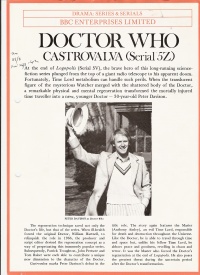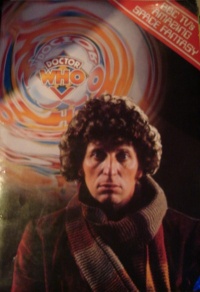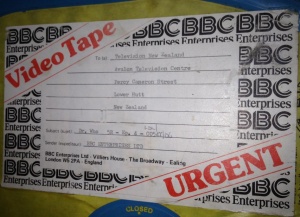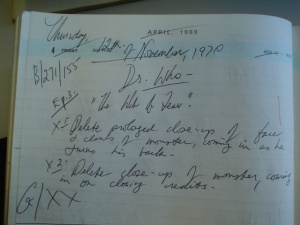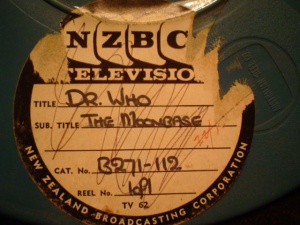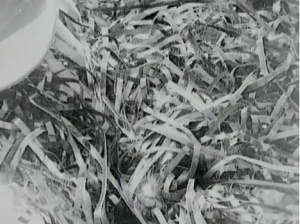Buying and Selling
THE PROCESS OF BUYING DOCTOR WHO
The process of selling and buying TV programmes has its complexities, and differs from country to country. This section offers a general overview of the sorts of processes that are known to have been applied to Doctor Who.
Contents
SELLING A TV SERIES
THE BBC SELLS TO OVERSEAS COUNTRIES
Like many programme-makers, the BBC had its own sales division, BBC Enterprises (later BBC Enterprises Limited, then BBC Worldwide). Enterprises had its own sub-agencies, BBC Toronto, in Canada, and BBC Sydney, in Australia. BBC Sydney catered for the Asian market.
According to a 1965 sales brochure, by that year, BBC Enterprises had six sales representatives on staff actively offering and selling Doctor Who around the world. Three of these reps operated from the BBC Enterprises offices in London, while the other three sales agents were based overseas. The six "regions" were:
- AUSTRALIA / NEW ZEALAND (office in Sydney)
- USA (office in New York)
- CANADA (office in Toronto)
- EUROPE (office in London)
- COMMONWEALTH, AFRICA, MIDDLE EAST (office in London)
- LATIN AMERICA, FAR EAST (office in London)
In the 1960s and 1970s, but less so into and beyond the 1980s, members of the Commonwealth of Nations operated a "quota" system, by which a percentage of all cinema releases and television programmes sold and purchased had to be products from other Commonwealth countries. The BBC therefore had an obligation under this quota system to sell Doctor Who (and other programming) to other Commonwealth nations.
Another agency that acted on the BBC's behalf was Television International Enterprises Ltd (TIE) / TIE (Programmes) Limited, which mainly served countries in the Caribbean, Africa and the Middle East.
The BBC also employed the services of distributors Time Life Films / Television to market its programmes throughout the United States and Central and South America.
One further distributor we know of was Overseas Rediffusion Limited (ORL), a subsidiary of Associated-Rediffusion Limited, who sold advertising time and programming mainly for radio, but also for television stations, in Barbados, Singapore, Malaysia, Thailand, Hong Kong and Malta. It is certainly documented in BBC records that ORL sold (at least) the first five Doctor Who stories (26 episodes) to Malta TV. Significantly, Barbados, Singapore and Hong Kong are three of the handful of countries that screened select stories from seasons three, four, five or six.
Given that distributors often held exclusive sales rights over the countries and regions for which they acted, the BBC probably could / would not offer and sell programmes directly to those countries. Interestingly, the number of TIE and ORL clients that screened the first series of Doctor Who but then dropped the series after The Rescue or The Time Meddler (see So Who Bailed on Who First?) is quite significant. This suggests that the two distributors stopped selling Doctor Who to a number of their clients because it was no longer financially viable for them to continue to do so, and the BBC was not able to step in and market, offer or sell the programme themselves. Could this be why sales of season three William Hartnell stories and all of the Patrick Troughton stories were so poor – because the BBC lost the support of TIE and ORL as distributors?
Sellers or distribution agents would make programme buyers aware of product by sending out promotional literature. For Doctor Who the BBC produced story synopses sheets, which featured episode by episode breakdowns and clippings from the Radio Times (such as the ones available as PDFs on the Peladon DVD box set) or Synopsis Cards (see the New Beginnings DVD box set), such as the one presented here for Castrovalva.)
Other literature such as industry journals, publications and magazines like Broadcasting, Back Stage and Variety, were also referenced to see and judge what programmes were considered popular in other countries.
Sellers, distributors and buyers also attended television programme junkets, such as:
- MIPCOM, held annually in October at Cannes, France, since 1985
- the annual (in March) NATPE exhibits in the United States. It was at the 1978 show that Time Life presented a lavish full colour glossy brochure for Doctor Who, which resulted in many sales of the Tom Baker serials to broadcasters within the US, as well as in Central and South America. (See United States--1978 for more on NATPE.)
- the BBC's own BBC Showcase, held at Brighton in February every year. (It was following the February 1977 sales fair that potential sales to Europe fell through (see Europe for more on this attempt))
- the sales junket held by the BBC in July 1985 in Nassau, which resulted in sales to several Caribbean countries
BUYING A TV SERIES
COUNTRIES BUY FROM THE BBC
There were six steps:
Offer / Audition
The BBC would send "letters of offer" to foreign television stations. These usually took the form of a letter listing the available programmes, together with "synopsis sheets" which summarised the series and storylines (sometime accompanied by a photocopy of the listings from the Radio Times). (A BBC memo dated 7 July 1965 exists which lists the countries to which Doctor Who had been offered, many of which (such as Japan and Switzerland) did not ultimately take up the offer put to them.)
Programme buyers could therefore choose and select only the stories which interested them; they were under no obligation to buy entire "seasons", a fact evidenced by the number of Doctor Who stories that didn't air in some countries.
If it was for a programme they had not seen before, the programme selector would often request to view an "audition", "pilot" or "viewing" copy. This was a sample of one or more episodes so they could judge whether the programme was worthy of buying. (Often sellers would entice potential buyers by providing copies of only the best episodes as auditions!)
During the 1960s, "audition" prints of Doctor Who were often sent from another broadcaster. It is known that the NZBC (New Zealand) supplied Denmark with prints of the first three William Hartnell stories, while Iran was supplied with episodes one and two only of Marco Polo. (Of the two, only Iran ended up buying the series on the basis of these "auditions".)
If a TV station was instead being offered further episodes of a series they had already auditioned and purchased, they did not repeat the above "audition" part of this section.
Acquisition
Once a TV station had agreed to buy a programme or series, it was up to the buyer to source and acquire the prints.
In some cases, the films would be supplied by the distributor itself. (The surviving film can from New Zealand's print of episode three of The Moonbase bears the "Programme Offer" or "Purchase Order" number P.O. 20691 on the label.)
If the seller and/or distributor were not able to supply the material directly, they would supply the buyer with a list of broadcasters who had previously bought the series, and the new buyer could contact those to arrange the importation of the film prints or tapes, at their own cost. (To reduce transportation costs, it was usual for broadcasters to source prints and tapes from countries in the same continent or region.) In the case of BBC programmes, BBC Enterprises would usually assist by liaising with previous broadcasters and instructing them to transport the required programmes to the next customer.
Sometimes when the prints eventually arrived from a foreign country, some were unusable; being in the wrong format or language, or not the ones that were ordered. This meant a broadcaster had to try and source replacement copies from somewhere else. (If necessary, the original distributor or seller might be required to provide copies from their own stocks.) This time-consuming acquisition process often justified why a three year rights period was often essential.
Censorship
Acquired programmes then went through the censorship process. Much has been documented about the Australian and New Zealand censorship of Doctor Who. (Censor clips have been recovered from both countries.) Little else is known about the censorship processes of other countries; it is however known that Hong Kong had very strict censorship controls.
Sometimes strict censorship meant that a programme or episode could not be aired. In the case of Australia, the government censors assigned classification ratings to some serials which meant they could not be aired in the early evening timeslots sought by the broadcaster. It is for this very reason that eight Doctor Who stories were "banned" from Australian screens in the 1960s and 1970s. And because those stories had been "banned" there, other Commonwealth or Asian countries could not buy them, because they were relying on Australia footing the clearances costs.
And should a programme or episode be unable to screen, then the TV station was under no obligation to purchase the rights to screen a programme (and if an advance had been paid, this would be refunded or held on credit to off-set future purchases).
Censorship was not the only reason why certain stories did not / could not be aired. Other factors could be:
- cost (the broadcaster might only have a budget for X episodes)
- scheduling (the broadcaster might have slots available for only X episodes)
- prints were not available (there are no available copies in circulation; other stations had not yet screened the prints they had)
- prints were unusable (e.g. due to damage)
- language (Arabic and Spanish-speaking countries could buy only those stories that had been dubbed into those languages)
- expiry of rights (the agreed rights periods had expired)
Purchase
Once all the legal formalities had been completed (e.g. censorship, cutting) the TV station agreed to buy a programme, or it could still decline if it had decided at this stage not to proceed.
If a programme had been rejected at the censorship stage, and didn't air, then no money was payable to the BBC. (The films would be held onto to await for disposal instructions.)
If a purchase was accepted, the BBC would issue an "invoice", and the station would pay the amount in full or in instalments at an agreed rate over an agreed term. Repeats were also negotiated if desired.
(In the case of sales to New Zealand, a formal "Programme Offer" which set out the terms of offer such as screening rights period and purchase price was issued in the form of a voucher. It contained a "Rights and Restrictions" clause, which basically specified the period within which the programme must be played - usually a term of two to three years.)
The amount payable was usually based around the number of licensed TV sets. Major Commonwealth countries such as Australia, New Zealand and Canada paid considerably high fees for the broadcast rights, because they had a high number of licensed TV sets in relation to the population, whereas some of the minor Commonwealth countries, such as in Africa, which had significantly large populations but only a relatively small number of TV sets making the potential viewing audience much smaller, paid significantly less.
Clearances
Once a clear offer had been made and accepted, it would be at that stage that the sale would be entered into the various registers at the BBC, and notification made to the relevant rights clearance departments within the BBC.
The BBC's Commercial Rights Department handled all the administration concerning copyright and royalties.
Clearances are recorded in a series of documents called Clearance History Sheets. There is one per serial, and they record the payments made by the BBC to the various copyright holders, such as Equity, script writer, musicians for each sale to a named country. The Clearance History Sheets for all but a few Hartnell and Troughton stories still exist (and the dates on which the notifications were sent formed the basis of a series of articles that appeared in DWM issues #444 and #445 in early 2012, although these were incorrectly attributed to being "sales" or "purchase" dates when in fact they should have been called "acceptance" dates).
Clearing the rights was sometimes a tricky and complex process, as different fees applied to different countries, based on geographical location (e.g. Africa, North America, Asia), language and whether or not they were part of the British Commonwealth. Rights had to be negotiated with the actor's union Equity, the Writers' Guild and Musicians' Union, who set the various levels of fees payable. (It was Equity who limited the number of sales and repeats the BBC could complete, which ultimately resulted in the junking of all the now-missing episodes...)
Of note, clearances were sometimes payable only once per territory or region, rather than by individual countries. Therefore the clearance fees were covered in full by the first country in that region to buy a series or episodes. Subsequent purchasers in that territory didn't have to pay any more than their negotiated price. (This is why many countries are often missing from BBC Records. There was a financial advantage to being down the pecking order, although one would get second hand rather than brand new prints as a consequence!)
Different broadcasters had negotiated maximum fees for buying programmes. Countries in which there were more than one broadcaster usually paid a much higher fee, to beat off the competition, whereas those countries that had only one broadcaster could negotiate a much lower fee.
To better explain the clearances and costs associated with buying BBC programmes, these comments from several articles on programme buying that appeared in The New Zealand Listener (*) offer very clear insights into the sales process:
- Prices vary according to what the market will bear: in Australia, an hour costs $4500, whereas in Germany it may be as high as $7000. In New Zealand, the NZBC paid between $300 and $400. (Values in New Zealand Dollars). (In the pre-decimal 1960s, the NZBC paid £100 per hour, and £50 per half hour.)
- Small countries like New Zealand miss getting some programmes because bigger neighbours are not interested and they cannot pay the BBC's costs alone. (This is why Doctor Who serials rejected in Australia end up not being sold to other Commonwealth countries.)
- Musician's Union in the UK costs are considerably high
- In the 1960s, the BBC found selling to the United States very tough because sponsors were frightened of offending minority groups, and non-US programmes often contained material that could be considered controversial
- The initial expenses – administration and copyright – have to be met early on in the sales process, so a sale to a major market like Australia covers those costs before the programme is even offered anywhere else
- Most programmes bought by the NZBC have been sold previously to Australia or Canada, who pay for all the upfront costs that NZBC can't afford to pay on its own
- The ABC in Australia has first refusal on all BBC programming
- The first refusal offer to major broadcasters was as a result of an agreement at a Commonwealth Broadcasting Conference, in that older Commonwealth broadcasting agencies would work together
- Not all programmes are immediately available for sale to New Zealand. When there are "residuals" to clear, a sale to the higher-paying Australian market must be made before TVNZ can buy. "Residuals" are payments to creative people – director and actors – at the time the programme is sold, and the complex rules vary from company to company
(*) New Zealand Listener 2 April 1965; 28 March 1969; 19 December 1969; 12 August 1978; 30 July 1983
These clearances paid for the residuals that were due to the contracted actors, the script writer, and for the use of music (both stock or specially composed scores). (Any of these persons could refuse to allow a sale to go ahead, for political, religious or other reasons; of course it was rare for this to happen with Doctor Who, as it would deny that person an income. The only documented instance in which a writer prevented the BBC from selling Doctor Who episodes overseas was when Terry Nation withdrew the rights to his Dalek stories while he attempted to sell his Dalek spin-off series idea to American networks during 1966 and 1967.)
The fee also covered the rights expiry period. The rights expiry period was essentially the time needed for the broadcaster to acquire, prepare, schedule and screen a programme. And given that the acquisition period (see below) sometimes took months - or years even - five years was sufficient if not generous. (And if it had been negotiated, also allowed for a repeat screening.) For Doctor Who, this period was for three, five or seven years. (When the rights period expired and there had been no further sales, the programme or episodes were withdrawn from offer. For instance, by mid-1974, the BBC was still offering these William Hartnell stories for sale: Inside the Spaceship, The Web Planet, The Space Museum, The Time Meddler, Galaxy 4, The War Machines, The Smugglers, The Tenth Planet, and - curiously – Mission to the Unknown. However, by mid-1975, this list had reduced to just the second, third, fourth and fifth stories of that list. As it so happens, Nigeria is the only country known to have bought anything from this list of stories - in 1973.)
After Broadcast
Once a broadcaster had aired the programme, they would usually hold onto the films for an indefinite period, waiting for instructions to either:
- (a) forward the prints or tapes to the next broadcaster who requested them (either the full set or just part); or as "audition" prints to different potential buyers
- (b) return the material to the original distributor / supplier / BBC
- (c) destroy the material...
This slapdash 'disposal' process is partly why the BBC's film library and archives held odds and ends and very few complete stories; that was all that had been returned to them from overseas...
Summary
In summary, the basic sales process was as follows:
- Offer made to TV station (memo / synopses sent)
- Audition / Viewing / Pilot prints provided if requested (bicycled in or supplied by the distributor – e.g. the BBC) [NOTE: This step is optional; it isn't compulsory]
- TV station sources film prints, either bicycled in or supplied by distributor – e.g. the BBC (see Bicycling Chains)
- Programmes are censored; they are passed or rejected
- TV station accepts or declines the offer
- If the former, BBC issues Invoice for payment, the TV station officially buys the programme (i.e. the rights to screen; they do not buy the actual film prints) [see NOTE below]
- BBC's Commercial Rights Department advised of acceptance, Clearance History Sheets noted
- Programme is transmitted
- Films / tapes are held onto then disposed of in terms of instructions from the distributor / supplier / BBC
NOTE: Some commentators have been puzzling over how and why episodes of Doctor Who have been located in countries they weren't sold to (i.e the sale is not in the clearance records), such as The Reign of Terror being found in Cyprus and an episode of The Crusade in New Zealand.
They are making a fundamental error; the sequence is not: OFFER / BUY / SOURCE / RECEIVE / ASSESS / SCREEN (i.e. Cyprus didn't buy it so why did it get the episodes?), but OFFER / SOURCE / RECEIVE / ASSESS / BUY / SCREEN (i.e. Cyprus got the episodes to assess before buying).
In other words, the BUY part of the transaction comes towards the end of the process, not at the beginning. The TV station buys the programme (i.e. hands over the cash, and the sale goes into the clearances records) after they have agreed to do so as the final step of the assessment process.
Under the former sequence, The Reign of Terror being found in Cyprus could indeed be seen as a bit of an oddity, but under the other, it's crystal clear.
This general overview touches on many of the main points surrounding selling and buying Doctor Who. There may be other factors and steps in the process that have not been taken into account here, but what is covered does give one a good feel for all the wheres, whys and hows that went into selling Doctor Who to the 70+ countries featured in BroaDWcast...
